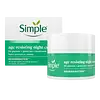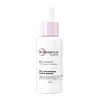Simple Skincare Regeneration Age Resisting Night Cream Versus Bio Essence Bio-White Pro Whitening Super Serum
What's inside
What's inside
 Key Ingredients
Key Ingredients

 Benefits
Benefits

 Concerns
Concerns

 Ingredients Side-by-side
Ingredients Side-by-side

Water
Skin ConditioningC12-15 Alkyl Benzoate
AntimicrobialBehenyl Behenate
EmollientGlycerin
HumectantSqualane
EmollientButylene Glycol
HumectantCetyl Palmitate
EmollientPolyhydroxystearic Acid
EmulsifyingPolyglyceryl-10 Stearate
Skin ConditioningPanthenol
Skin ConditioningDimethicone
EmollientPhenoxyethanol
PreservativeCarbomer
Emulsion StabilisingEuphorbia Cerifera Cera
AstringentSodium Stearoyl Lactylate
EmulsifyingTocopheryl Acetate
AntioxidantSodium Hydroxide
BufferingEthylhexylglycerin
Skin ConditioningPentylene Glycol
Skin ConditioningSerine
MaskingSodium Lactate
BufferingLactic Acid
BufferingUrea
BufferingFomes Officinalis Extract
Skin ProtectingSorbitol
HumectantPantolactone
HumectantPEG-40 Hydrogenated Castor Oil
EmulsifyingBisabolol
MaskingBorago Officinalis Seed Oil
EmollientSodium Chloride
MaskingPropylene Glycol
HumectantAllantoin
Skin ConditioningCamellia Sinensis Leaf Extract
AntimicrobialWater, C12-15 Alkyl Benzoate, Behenyl Behenate, Glycerin, Squalane, Butylene Glycol, Cetyl Palmitate, Polyhydroxystearic Acid, Polyglyceryl-10 Stearate, Panthenol, Dimethicone, Phenoxyethanol, Carbomer, Euphorbia Cerifera Cera, Sodium Stearoyl Lactylate, Tocopheryl Acetate, Sodium Hydroxide, Ethylhexylglycerin, Pentylene Glycol, Serine, Sodium Lactate, Lactic Acid, Urea, Fomes Officinalis Extract, Sorbitol, Pantolactone, PEG-40 Hydrogenated Castor Oil, Bisabolol, Borago Officinalis Seed Oil, Sodium Chloride, Propylene Glycol, Allantoin, Camellia Sinensis Leaf Extract
Water
Skin ConditioningPanthenol
Skin ConditioningMethylpropanediol
SolventBetaine
Humectant3-O-Ethyl Ascorbic Acid
Skin ConditioningHydroxypropyl Cyclodextrin
MaskingCyclodextrin
AbsorbentPolydextrose
HumectantResveratrol
AntioxidantPEG-12 Dimethicone
Skin ConditioningSclerotium Gum
Emulsion StabilisingSodium Polyacryloyldimethyl Taurate
Emulsion StabilisingBis-PEG-18 Methyl Ether Dimethyl Silane
EmollientSodium Hyaluronate
HumectantGlyceryl Stearate
EmollientAlpha-Arbutin
AntioxidantPolysorbate 80
EmulsifyingEthylhexylglycerin
Skin ConditioningLimonia Acidissima Extract
Skin ConditioningNiacinamide
SmoothingPentylene Glycol
Skin ConditioningBroussonetia Papyrifera Bark Extract
Skin ConditioningAcetyl Glucosamine
Skin ConditioningMorus Alba Bark Extract
Skin ConditioningPyrus Malus Fruit Extract
Skin ConditioningCamellia Japonica Flower Extract
EmollientCamellia Sinensis Leaf Extract
AntimicrobialMadecassoside
AntioxidantRhus Semialata Extract
Skin ConditioningTricholoma Matsutake Extract
Skin ConditioningLactic Acid
BufferingButylene Glycol
HumectantDextran
Nonapeptide-1
Skin ConditioningEuglena Gracilis Extract
Skin ConditioningPotassium Sorbate
PreservativeTocopherol
AntioxidantPhenoxyethanol
PreservativeChlorphenesin
AntimicrobialSodium Metabisulfite
AntioxidantDisodium EDTA
Water, Panthenol, Methylpropanediol, Betaine, 3-O-Ethyl Ascorbic Acid, Hydroxypropyl Cyclodextrin, Cyclodextrin, Polydextrose, Resveratrol, PEG-12 Dimethicone, Sclerotium Gum, Sodium Polyacryloyldimethyl Taurate, Bis-PEG-18 Methyl Ether Dimethyl Silane, Sodium Hyaluronate, Glyceryl Stearate, Alpha-Arbutin, Polysorbate 80, Ethylhexylglycerin, Limonia Acidissima Extract, Niacinamide, Pentylene Glycol, Broussonetia Papyrifera Bark Extract, Acetyl Glucosamine, Morus Alba Bark Extract, Pyrus Malus Fruit Extract, Camellia Japonica Flower Extract, Camellia Sinensis Leaf Extract, Madecassoside, Rhus Semialata Extract, Tricholoma Matsutake Extract, Lactic Acid, Butylene Glycol, Dextran, Nonapeptide-1, Euglena Gracilis Extract, Potassium Sorbate, Tocopherol, Phenoxyethanol, Chlorphenesin, Sodium Metabisulfite, Disodium EDTA
 Reviews
Reviews

Ingredients Explained
These ingredients are found in both products.
Ingredients higher up in an ingredient list are typically present in a larger amount.
Butylene Glycol (or BG) is used within cosmetic products for a few different reasons:
Overall, Butylene Glycol is a safe and well-rounded ingredient that works well with other ingredients.
Though this ingredient works well with most skin types, some people with sensitive skin may experience a reaction such as allergic rashes, closed comedones, or itchiness.
Learn more about Butylene GlycolCamellia Sinensis Leaf Extract is derived from the leaves of the tea plant. Black tea, green tea, and oolong tea are all harvested from this plant.
This ingredient has many skin benefits:
This ingredient contains polyphenols, a strong antioxidant. Antioxidants help fight off molecules that damage skin cells.
On top of that, the antioxidants in green tea neutralize free-radicals from the sun. This gives the skin some extra UV protection, but should not replace sunscreen.
Many components of tea have anti-inflammatory properties.
Polyphenols and L-theanine help soothe the skin and reduce irritation. The caffeine in Camellia Sinensis Leaf Extract helps calm inflamed blood vessels.
Other compounds found in tea include: Vitamin Bs, linoleic acid, magnesium, calcium, iron, and zinc.
Research has shown both drinking Camellia Sinensis Leaf Tea and applying it to the skin can help boost skin elasticity and hydration. Studies also show using tea extract may reduce sebum, or oil, production.
Learn more about Camellia Sinensis Leaf ExtractEthylhexylglycerin (we can't pronounce this either) is commonly used as a preservative and skin softener. It is derived from glyceryl.
You might see Ethylhexylglycerin often paired with other preservatives such as phenoxyethanol. Ethylhexylglycerin has been found to increase the effectiveness of these other preservatives.
Lactic Acid is another well-loved alpha hydroxy acid (AHA). It is gentler than glycolic acid but still highly effective.
Its main role is to exfoliate the surface of the skin by loosening the “glue” that holds dead skin cells together. Shedding those old cells leads to smoother, softer, and more even-toned skin.
Because lactic acid molecules are larger than glycolic acid, they don’t penetrate as deeply. This means they’re less likely to sting or irritate, making it a great choice for beginners or those with sensitive skin.
Like glycolic acid, it can:
Lactic acid also acts as a humectant (like hyaluronic acid). It can draw water into the skin to improve hydration and also plays a role in the skin's natural moisturizing factor (NMF) in the form of sodium lactate.
Studies show it can boost ceramide production to strengthen the skin barrier and even help balance the skin’s microbiome.
To get results, choose products with a pH between 3-4.
Lower strengths (5-12%) focus on surface exfoliation; higher strengths (12% and up) can reach deeper in the dermis (deeper, supportive layer) to improve skin texture and firmness over time.
Though it was originally derived from milk, most modern lactic acid used in skincare is vegan. It is made through non-dairy fermentation to create a bio-identical and stable form suitable for all formulations.
When lactic acid shows up near the end of an ingredient list, it usually means the brand added just a tiny amount to adjust the product’s pH.
Legend has it that Cleopatra used to bathe in sour milk to help reduce wrinkles.
Lactic acid is truly a gentle multitasker: it exfoliates, hydrates, strengthens, and brightens. It's a great ingredient for giving your skin a smooth, glowing, and healthy look without the harshness of stronger acids.
Read more about some other popular AHA's here:
Learn more about Lactic AcidPanthenol is a common ingredient that helps hydrate and soothe the skin. It is found naturally in our skin and hair.
There are two forms of panthenol: D and L.
D-panthenol is also known as dexpanthenol. Most cosmetics use dexpanthenol or a mixture of D and L-panthenol.
Panthenol is famous due to its ability to go deeper into the skin's layers. Using this ingredient has numerous pros (and no cons):
Like hyaluronic acid, panthenol is a humectant. Humectants are able to bind and hold large amounts of water to keep skin hydrated.
This ingredient works well for wound healing. It works by increasing tissue in the wound and helps close open wounds.
Once oxidized, panthenol converts to pantothenic acid. Panthothenic acid is found in all living cells.
This ingredient is also referred to as pro-vitamin B5.
Learn more about PanthenolPentylene glycol is typically used within a product to thicken it. It also adds a smooth, soft, and moisturizing feel to the product. It is naturally found in plants such as sugar beets.
The hydrophilic trait of Pentylene Glycol makes it a humectant. As a humectant, Pentylene Glycol helps draw moisture from the air to your skin. This can help keep your skin hydrated.
This property also makes Pentylene Glycol a great texture enhancer. It can also help thicken or stabilize a product.
Pentylene Glycol also acts as a mild preservative and helps to keep a product microbe-free.
Some people may experience mild eye and skin irritation from Pentylene Glycol. We always recommend speaking with a professional about using this ingredient in your routine.
Pentylene Glycol has a low molecular weight and is part of the 1,2-glycol family.
Learn more about Pentylene GlycolPhenoxyethanol is a preservative that has germicide, antimicrobial, and aromatic properties. Studies show that phenoxyethanol can prevent microbial growth. By itself, it has a scent that is similar to that of a rose.
It's often used in formulations along with Caprylyl Glycol to preserve the shelf life of products.
Water. It's the most common cosmetic ingredient of all. You'll usually see it at the top of ingredient lists, meaning that it makes up the largest part of the product.
So why is it so popular? Water most often acts as a solvent - this means that it helps dissolve other ingredients into the formulation.
You'll also recognize water as that liquid we all need to stay alive. If you see this, drink a glass of water. Stay hydrated!
Learn more about Water